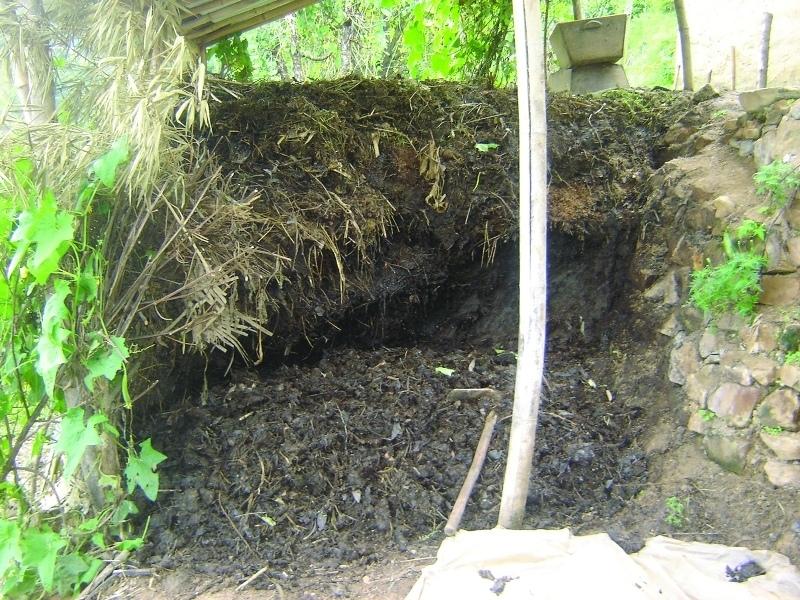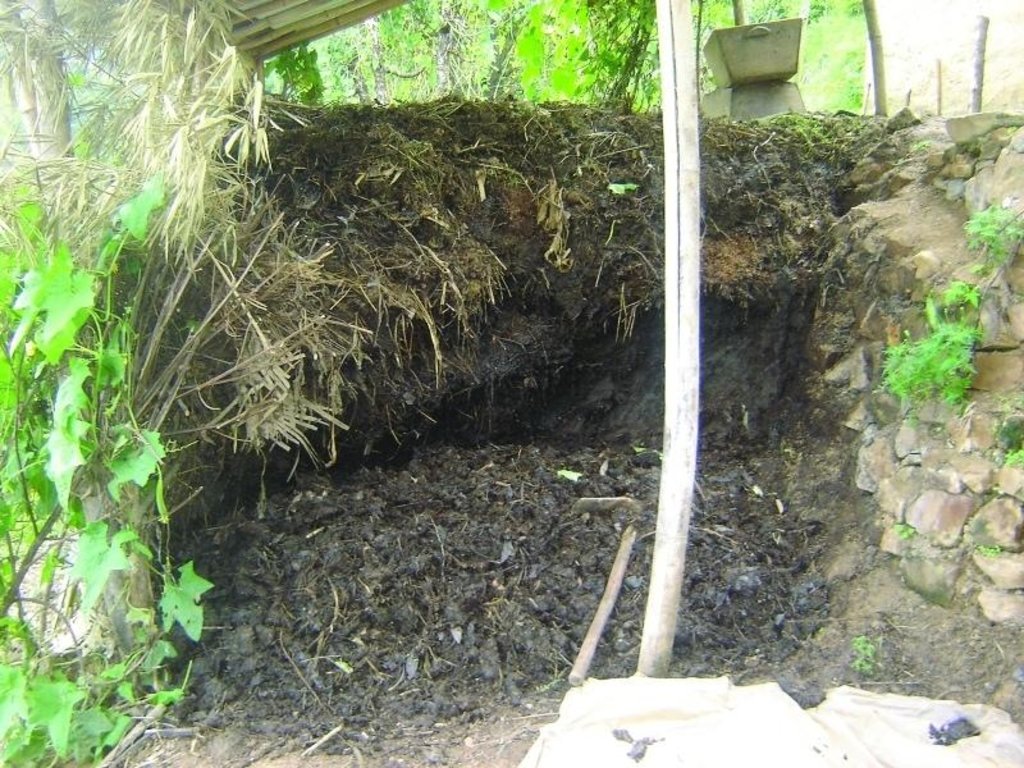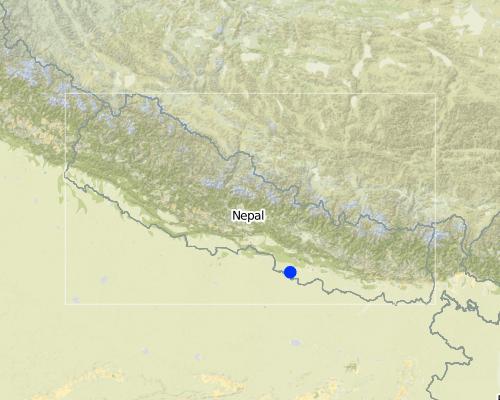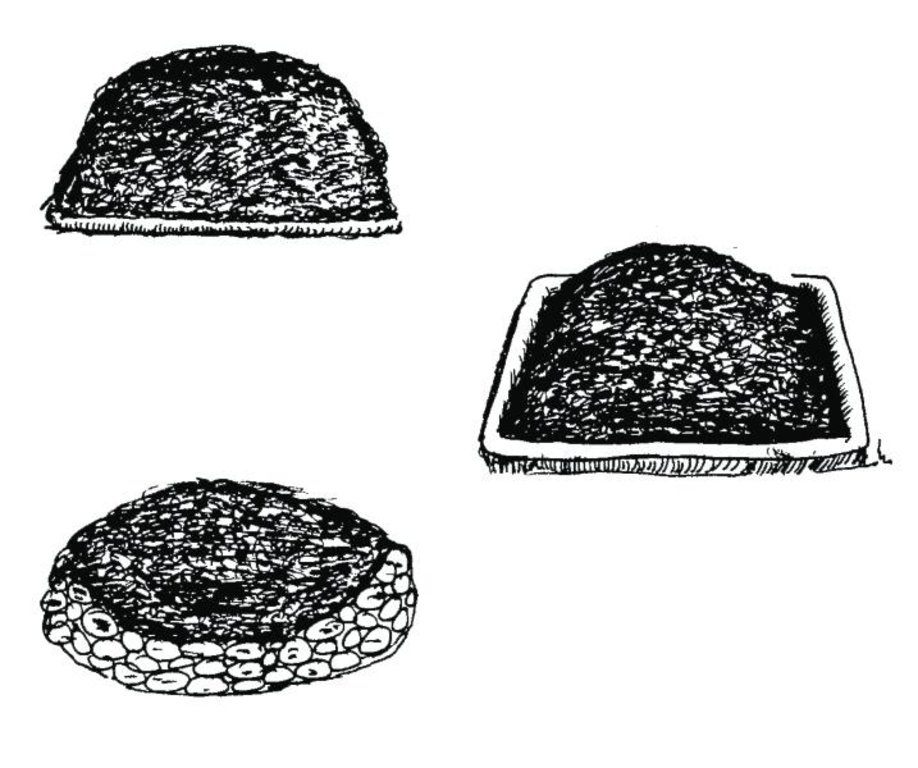Better quality farmyard manure through improved decomposition [Népal]
- Création :
- Mise à jour :
- Compilateur : Richard Allen
- Rédacteur : –
- Examinateur : David Streiff
Upayukta bighatan prakriya dwara ramro gunastar ko gothemal (Nepali)
technologies_1759 - Népal
Voir les sections
Développer tout Réduire tout1. Informations générales
1.2 Coordonnées des personnes-ressources et des institutions impliquées dans l'évaluation et la documentation de la Technologie
Spécialiste GDT:
Director
+977 1 5520314
Soil Management Directorate, Department of Agriculture
Népal
Spécialiste GDT:
Team Leader
+977 1 5543591
ssmp@helvetas.org.np
Sustainable Soil Management Programme
GPO Box 688, Kathmandu/Nepal
Népal
Nom du projet qui a facilité la documentation/ l'évaluation de la Technologie (si pertinent)
Sustainable Soil Management Programme, Nepal (SSMP)Nom du ou des institutions qui ont facilité la documentation/ l'évaluation de la Technologie (si pertinent)
Department of Agriculture, Soil Management Directorate, Hariharbhawan Lalitpur (doasoil) - NépalNom du ou des institutions qui ont facilité la documentation/ l'évaluation de la Technologie (si pertinent)
HELVETAS (Swiss Intercooperation)1.3 Conditions relatives à l'utilisation par WOCAT des données documentées
Quand les données ont-elles été compilées (sur le terrain)?
07/11/2008
Le compilateur et la(les) personne(s) ressource(s) acceptent les conditions relatives à l'utilisation par WOCAT des données documentées:
Oui
1.5 Référence au(x) questionnaire(s) sur les Approches de GDT

Farmer field schools on integrated plant nutrient systems [Népal]
Participatory and collaborative learning through the farmer field school approach
- Compilateur : Richard Allen

Farmer-to-farmer diffusion [Népal]
Wider diffusion of sustainable soil management technologies through a demand responsive farmer-to-farmer diffusion approach
- Compilateur : Richard Allen
2. Description de la Technologie de GDT
2.1 Courte description de la Technologie
Définition de la Technologie:
Collection and proper storage of farmyard manure in heaps or pits
2.2 Description détaillée de la Technologie
Description:
Farmyard manure - a varying mixture of animal manure, urine, bedding material, fodder residues, and other components - is the most common form of organic manure applied in the midhills of Nepal. Farmyard manure has a high proportion of organic material which nurtures soil organisms and is essential in maintaining an active soil life. Only about half of the nutrient content of farmyard manure becomes available for crop growth during the first year after it has been applied to the soil - the rest is channeled through soil biotic processes and the nutrients are released in the following years. The high organic matter content and the active soil life improve or maintain friable soil structures, increase the cation exchange capacity, water holding capacity, and infiltration rate, and reducing the risk of soil pests building up.
Indigenous methods of preparing and using farmyard manure vary widely depending on the ecological zone, access to bedding material from crop or forest land, access to crop residues and fodder, labour availability, and other factors. A prerequisite for the manure having a positive impact on soil fertility is that it is properly decomposed. The application of partially decomposed manure can increase the number of white grubs, red ants and other soil pests.
Decomposition is enhanced and the time it takes to happen is reduced if the manure is kept warm and moist (but not wet) at all times. Heaping the manure up or storing it in a pit helps. Whether it is best to heap up the manure or put it in a pit depends on the local climate. Heaping has the advantage of being less costly, while the pit method reduces runoff and the loss of nutrient rich fluids. Adding nitrogen in the form of urine (N) improves the carbon to nitrogen ratio.
2.3 Photos de la Technologie
2.5 Pays/ région/ lieux où la Technologie a été appliquée et qui sont couverts par cette évaluation
Pays:
Népal
Autres spécifications du lieu:
Midhills districts of Nepal
Map
×3. Classification de la Technologie de GDT
3.1 Principal(aux) objectif(s) de la Technologie
- Access to manure
3.2 Type(s) actuel(s) d'utilisation des terres, là où la Technologie est appliquée

Terres cultivées
- Cultures annuelles
Commentaires:
Major land use problems (compiler’s opinion): Intensifying cultivation practices with either 1) inadequate application of fertilisers leading to a decline in soil fertility and the mining of soil nutrients or 2) application of too much fertiliser causing environmental problems through excessive leaching, and losses of fertiliser in surface runoff and consequent eutrophication or nitrification of streams, ponds or groundwater.
3.4 Groupe de GDT auquel appartient la Technologie
- gestion intégrée de la fertilité des sols
3.5 Diffusion de la Technologie
Spécifiez la diffusion de la Technologie:
- appliquée en des points spécifiques ou concentrée sur une petite surface
3.6 Mesures de GDT constituant la Technologie

modes de gestion
- M2: Changement du niveau de gestion / d'intensification
3.7 Principaux types de dégradation des terres traités par la Technologie

dégradation chimique des sols
- Cn: baisse de la fertilité des sols et réduction du niveau de matière organique (non causée par l’érosion)
3.8 Prévention, réduction de la dégradation ou réhabilitation des terres dégradées
Spécifiez l'objectif de la Technologie au regard de la dégradation des terres:
- réduire la dégradation des terres
4. Spécifications techniques, activités, intrants et coûts de mise en œuvre
4.1 Dessin technique de la Technologie
4.2 Spécification/ explications techniques du dessin technique
a) Heap method
b) Pit method
c) Semi-pit method
The method should be chosen that
is most convenient and provides the
most favourable environment for
decomposition of the manure.
Generally heaps and pits are about 1 to 2m in diameter
depending on the amount of
manure produced and required.
Technical knowledge required for field staff / advisors: low
Technical knowledge required for land users: low
Main technical functions: increase in organic matter, increase in soil fertility, increase in soil productivity
Secondary technical functions: increased infiltration rate and water holding capacity, improved soil physical properties
Layout change according to natural and human environment: heaping or storage in pits
4.3 Informations générales sur le calcul des intrants et des coûts
Indiquez la monnaie utilisée pour le calcul des coûts:
- dollars US
Indiquez le coût salarial moyen de la main d'œuvre par jour:
2.00
4.4 Activités de mise en place/ d'établissement
| Activité | Type de mesures | Calendrier | |
|---|---|---|---|
| 1. | Dig a 1m deep and 2m diameter pit using a shovel or spade. | Modes de gestion | |
| 2. | Pit method: Put dung mixed with leaf litter, bedding material and fodder residues in the pit until it is full. | Modes de gestion | |
| 3. | Apply urine directly over the manure heap using a plastic pipe or jug. | Modes de gestion | |
| 4. | Cover the heap with a fine layer of straw, mud, soil or plastic sheet or any other suitable local materials to protect it from direct sunlight and excessive water. | Modes de gestion |
4.5 Coûts et intrants nécessaires à la mise en place
| Spécifiez les intrants | Unité | Quantité | Coûts par unité | Coût total par intrant | % des coût supporté par les exploitants des terres | |
|---|---|---|---|---|---|---|
| Main d'œuvre | Preapring manure pit | Persons/day | 1,0 | 2,0 | 2,0 | 100,0 |
| Coût total de mise en place de la Technologie | 2,0 | |||||
4.6 Activités d'entretien/ récurrentes
| Activité | Type de mesures | Calendrier/ fréquence | |
|---|---|---|---|
| 1. | About one month after beginning to collect and pile up the material, turn | Modes de gestion | |
| 2. | Depending on the location, it takes about 3-4 months to prepare fully decomposed farmyard manure. | Modes de gestion |
4.7 Coûts et intrants nécessaires aux activités d'entretien/ récurrentes (par an)
| Spécifiez les intrants | Unité | Quantité | Coûts par unité | Coût total par intrant | % des coût supporté par les exploitants des terres | |
|---|---|---|---|---|---|---|
| Main d'œuvre | Decompose manure | Persons/day | 1,0 | 2,0 | 2,0 | 100,0 |
| Coût total d'entretien de la Technologie | 2,0 | |||||
Commentaires:
Cost as in January 2007
4.8 Facteurs les plus importants affectant les coûts
Décrivez les facteurs les plus importants affectant les coûts :
The heap method is cheaper, as no digging is involved
5. Environnement naturel et humain
5.1 Climat
Précipitations annuelles
- < 250 mm
- 251-500 mm
- 501-750 mm
- 751-1000 mm
- 1001-1500 mm
- 1501-2000 mm
- 2001-3000 mm
- 3001-4000 mm
- > 4000 mm
Spécifications/ commentaires sur les précipitations:
Annual rainfall: Also 2000-3000 mm
Zone agro-climatique
- humide
Thermal climate class: subtropics
5.2 Topographie
Pentes moyennes:
- plat (0-2 %)
- faible (3-5%)
- modéré (6-10%)
- onduleux (11-15%)
- vallonné (16-30%)
- raide (31-60%)
- très raide (>60%)
Reliefs:
- plateaux/ plaines
- crêtes
- flancs/ pentes de montagne
- flancs/ pentes de colline
- piémonts/ glacis (bas de pente)
- fonds de vallée/bas-fonds
Zones altitudinales:
- 0-100 m
- 101-500 m
- 501-1000 m
- 1001-1500 m
- 1501-2000 m
- 2001-2500 m
- 2501-3000 m
- 3001-4000 m
- > 4000 m
Commentaires et précisions supplémentaires sur la topographie:
Slopes on average: Also moderate (6-10%), rolling (11-15%) and hilly (16-30%)
Landforms: Also footslopes
Altitudinal zone: Also 1000-1500 m a.s.l., 1500-2000 m a.s.l. and 2000-2500 m a.s.l.
5.6 Caractéristiques des exploitants des terres appliquant la Technologie
Orientation du système de production:
- subsistance (auto-approvisionnement)
- mixte (de subsistance/ commercial)
Individus ou groupes:
- individu/ ménage
Indiquez toute autre caractéristique pertinente des exploitants des terres:
Off-farm income specification: In most farm households, off-farm income plays at least a minor and increasingly a major role. Occasional opportunities for off-farm income present themselves in the form of daily labour wages. Some households’ members receive regular salaries, whilst an increasing number of Nepalis are working in India, the Middle East, Malaysia, and elsewhere and sending remittance incomes home.
Market orientation of production system: Also commercial/ market
5.7 Superficie moyenne des terres détenues ou louées par les exploitants appliquant la Technologie
- < 0,5 ha
- 0,5-1 ha
- 1-2 ha
- 2-5 ha
- 5-15 ha
- 15-50 ha
- 50-100 ha
- 100-500 ha
- 500-1 000 ha
- 1 000-10 000 ha
- > 10 000 ha
5.8 Propriété foncière, droits d’utilisation des terres et de l'eau
Propriété foncière:
- individu, sans titre de propriété
- individu, avec titre de propriété
Droits d’utilisation des terres:
- loué
- individuel
Commentaires:
sharecropping between owner and tenant
6. Impacts et conclusions
6.1 Impacts sur site que la Technologie a montrés
Impacts socio-économiques
Production
production agricole
Revenus et coûts
dépenses pour les intrants agricoles
Commentaires/ spécifiez:
Reduced cash expenses on agrochemicals (fertilisers, pesticides; substituted by labour)
Autres impacts socio-économiques
Cleaner environment around houses if manure heap or pit is well maintained
Impacts écologiques
Autres impacts écologiques
Incidence ofsoil pests (white grub, red ant)
Application of mineral fertilisers
6.2 Impacts hors site que la Technologie a montrés
pollution des rivières/ nappes phréatiques
Commentaires/ spécifiez:
Reduced influx of nutrients into water bodies
Dependence on outside inputs
6.4 Analyse coûts-bénéfices
Quels sont les bénéfices comparativement aux coûts de mise en place (du point de vue des exploitants des terres)?
Rentabilité à court terme:
positive
Rentabilité à long terme:
positive
Quels sont les bénéfices comparativement aux coûts d'entretien récurrents (du point de vue des exploitants des terres)?
Rentabilité à court terme:
positive
Rentabilité à long terme:
positive
Commentaires:
The high costs of mineral fertiliser mean that the establishment costs are recovered quarterly. Over the long-term, the major reduction in costs leads to large benefits.
6.5 Adoption de la Technologie
Commentaires:
Comments on acceptance with external material support: Heap and pit methods have been very well accepted and adopted widely ( 60-70% ) of among participants in SSMP.The semi-pit method is not as accepted as the other methods due to its high initial establishment costs.
6.7 Points forts/ avantages/ possibilités de la Technologie
| Points forts/ avantages/ possibilités du point de vue du compilateur ou d'une autre personne ressource clé |
|---|
|
The use of improved and well-decomposed farmyard manure reduced the need for mineral fertiliser and pesticides thereby reducing production costs, cash expenditure, and outside dependency How can they be sustained / enhanced? Further promote the technology to increase this impact. |
| The use of fully decomposed farmyard manure reduces pest incidence, especially attacks of red ants and white grubs |
6.8 Faiblesses/ inconvénients/ risques de la Technologie et moyens de les surmonter
| Faiblesses/ inconvénients/ risques du point de vue du compilateur ou d'une autre personne ressource clé | Comment peuvent-ils être surmontés? |
|---|---|
| The initial establishment costs for building a semi-pit may hamper adoption |
Promote alternative methods of building a semi-pit without using cement and using local resources |
7. Références et liens
7.2 Références des publications disponibles
Titre, auteur, année, ISBN:
STSS; SSMP (2001) Farmyard Manure and Compost Management (in Nepali) Kathmandu: Soil Testing Services Section, Department of Agriculture and Sustainable Soil Management Programme
Disponible à partir d'où? Coût?
SSMP
Liens et modules
Développer tout Réduire toutLiens

Farmer field schools on integrated plant nutrient systems [Népal]
Participatory and collaborative learning through the farmer field school approach
- Compilateur : Richard Allen

Farmer-to-farmer diffusion [Népal]
Wider diffusion of sustainable soil management technologies through a demand responsive farmer-to-farmer diffusion approach
- Compilateur : Richard Allen
Modules
Aucun module trouvé





